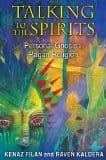
 Talking to the Spirits: Personal Gnosis in Pagan Religion, by Kenaz Filan and Raven Kaldera
Talking to the Spirits: Personal Gnosis in Pagan Religion, by Kenaz Filan and Raven Kaldera
Destiny Books, 9781620550830, 320 pp., 2013
This book is an excellent exploration of communication with the spirit world with material of interest to the curious, the absolute beginner, and the experience spirit- worker. While it is primarily informed by Northern Tradition Paganism, it draws first hand examples from a wide array of spirit-workers from a variety of paganisms, including Asatru, Heathens, Druids, Celtic Reconstructionists, Hellenics, Kemetics, modern Shamans, and more. It also does an excellent job reminding us that these communications take place in cultural contexts and in the broader context of the natural world itself.
The book begins with an exploration of what personal gnosis is and what it feels like; and since much of the information we receive from the spirits can not be verified and may not be for everyone, how we can respond to what the gods, ancestors, and spirits are telling us. It explores why we want to cultivate more direct communication, what that communication might look like, and some of the risks and dangers along the way.
The book frankly addresses delusion, scepticism, lies, and inflated egos in a way which is constructive – discerning without being overly judgemental. It also has an entire chapter addressing the relationship between spirit contact and mental health concerns, do so in a way which is supportive, sensitive and informed. Too many books on magical practices simply say that anyone with any mental health issues should simply avoid esoteric work; but that ignores the fact that much healing can be found in these practices and that some of the sensitivities that leave certain people vulnerable to mental illness can be the same sensitivities that leave some of the same people open to spiritual awareness. Managing these gifts and burdens together seems to me to be a far cry better than shutting everything down because some ‘spiritual leaders’ don’t have the skills to mentor such individuals. Given that I work in the intersection of spirituality and mental health, I was delighted to see it introduced so well here.
There are also entire chapters devoted to enhancing “signal clarity” and others to interpreting the material one gets. There is also attention given to how we apply these messages in our own lives, when divining for a group, and when practicing as a group of seers together. Responsibility and the need for integrity is a theme threaded throughout the entire text: responsibility to our ancestors and the cultures we draw upon, responsibility to our community and the world we share today, responsibility to the gods and spirits, and responsibility to our own Spiritual process are addressed both frankly and kindly.
Overall, this is a very serious book, but it’s conversational and anecdotal style saves serious from becoming sombre or stifling. It has many words of encouragement, and stories that illustrate what can go well and what can go badly. The book made me smile or laugh quite often. For example when disagreeing about how a given deity is perceived: “‘I disagree with your statement about X’ is good. ‘You are a bunch of delusional idiots’, is bad.”1 Out of context it’s not as funny, but in it works context; and if you’ve ever argued with Pagans online it’s hilarious.
I would recommend this book to anyone interested in including more active spirit-work into their personal practice, or even to someone curious about how that might look. I don’t think it can be a stand alone one-stop-shop for all things related to spirit contact, but combined with Diane Paxon’s Trance-Portation2 or even some of Kaldera’s earlier books, it a good foundation for not only working with the spirits, but working with what the spirits give you out in the world.
- p. 287 [↩]
- See also our review of Paxon’s The Way of the Oracle. [↩]








